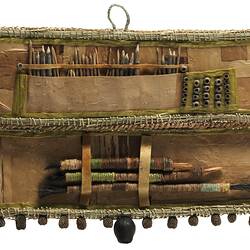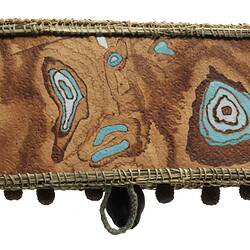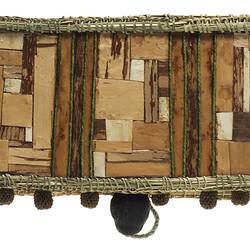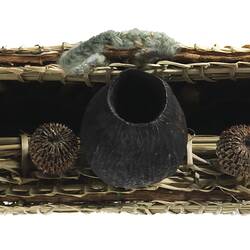Summary
Title of work is "Yorta Yorta Tool Kit 1".
Physical Description
Tool kit consisting of a wallet or shallow box, containing three paint brushes/incising tools and 33 wood pegs. The three brushes are secured in position to the base of the wallet with two leather straps. (1) brush consists of a twig wrapped with twine with two tufts of coarse hair attached at both ends; (2) brush consists of a twig wrapped with twine with one tuft of soft hair attached at one end and three fine wood needles attached at the other end; (3) brush consists of a twig wrapped with twine with one tuft of soft hair attached at one end and four fine wood needles attached at the other end. Attached to the inside cover of the wallet is a pocket containing 33 pegs (small, sharpened at one end, blunt at the other end) and decorated with 26 gum nuts adhered to the inside cover. The wallet or shallow box is fabricated from layers of fine paperbark, trimmed and adhered in an overlay construction. The cover and base of the wallet are trimmed with woven grass coiled bundles using a button hole (check) stitch. The cover and base are attached along the length of one side with a hinge stitched from twine. The outside base of the box consists of adhered paper bark pieces interspersed with single strips of green dyed twine. The woven edge of the base is decorated with attached seed pods, culminating with a large gum nut clasp at the centre, aligned with a plaited wool loop attached to the edge of the cover. The cover of the box is painted in 'pools' of blue and brown paint. Artist's name and date written towards edge, inside the base of the wallet 'Hamm 2012'.
Significance
Yorta Yorta Artist Treahna Hamm explains:
'Yorta Yorta Tool Kits 1 and 2 were inspired by traditional Aboriginal knowledge from along the Murray River. The paintbrushes and wooden implements were created from eucalyptus and bottlebrush wood from my neighbourhood, where I grew up near Dhungala (the Murray River) in Yarrawonga. The paintbrushes consist of kangaroo sinew and dyed string, and use both traditional and contemporary means. My Aunty once taught me how to dye string from bark near the river. The bark produced pinks, which vary in colour depending on how long they are left to absorb the dispersing of dye. This was used in conjunction with contemporary dyes. Some of the tools were then inscribed with a burner to denote country (symbols) where the tool-making took place. Mussel shells found along the river were used to create the scrapers. The mussel shells are strong and were originally used to scrape fish flesh when preparing it for eating. I used fishing line, which depicts 'Country' in a contemporary form, to sew the seed pods onto the boxes for decorative purposes. Traditional pegs were made from local trees along the river, mainly bottlebrush, which links to both the paintbrushes and my totem. I wanted to incorporate facets of what I saw important as both a traditional and contemporary art practitioner. What I didn't realise when making the Tool Kits was that I would use the pegs in the process, making holes in the woven lamandra edging so that the stalks of the decorative pods could be glued and secured. Also some painting was done with the brushes. The Yorta Yorta Tool Kits were produced to highlight traditional items that could be used in contemporary contexts and formats, continuing the link to ancestors in Victoria'. Treahna Hamm, 2013.
More Information
-
Object/Medium
Container
-
Maker
-
Cultural Groups
-
Locality
-
Date Produced
-
Fully Extended
420 mm (Length), 275 mm (Width), 40 mm (Height)
Closed: W 112mm.
-
Classification
-
Date Made
-
Maker
-
Clan/Language Group
-
Place Made
-
Indigenous Region
-
Keywords
-
Type of item
-
Discipline
-
Category
-
Collecting Areas




